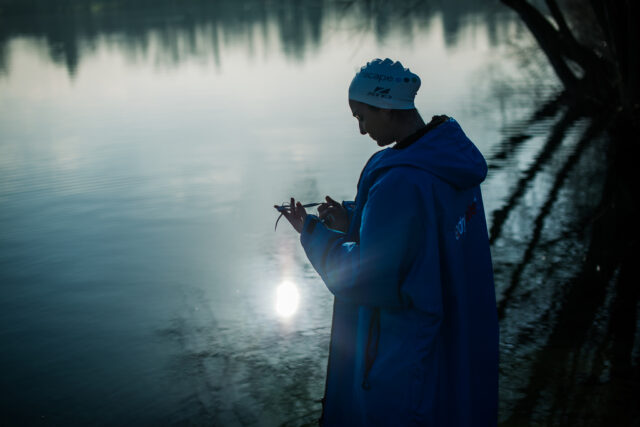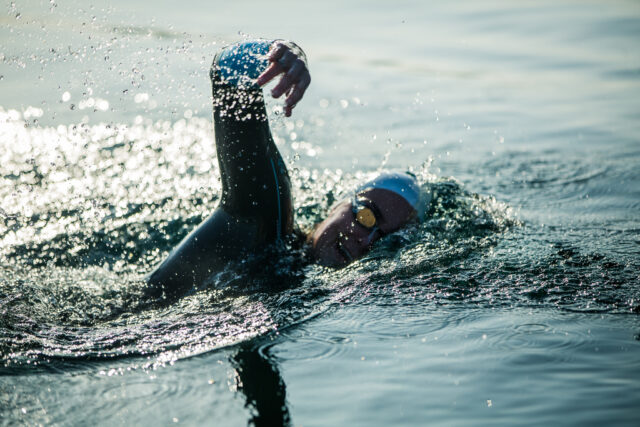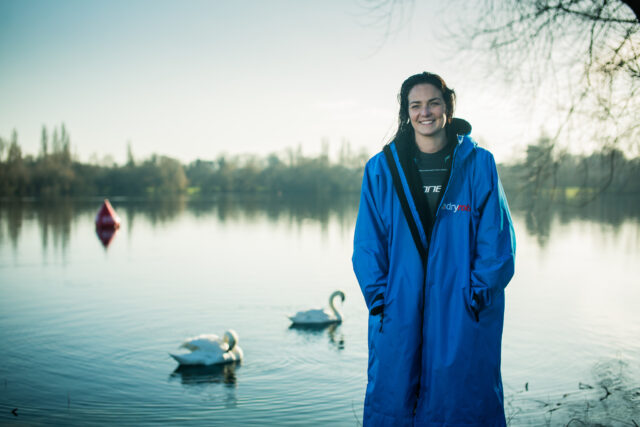Courtesy of dryrobe®, a SwimSwam partner.
As water temperatures drop, continuing to open water swim in the winter may feel less feasible. But for some, the challenging conditions and icy temperatures make winter swims all the more exciting! In fact, some describe the experience of winter swimming as transformative, enjoying the mental challenge of swimming in cold temperatures and discovering communities of other cold water swimmers.
If you’re hoping to swim throughout the coldest months of the year, but are not too sure where to start, Olympic open water swimmer and dryrobe® Ambassador, Keri-anne Payne shares her expert advice in our most recent chat.
British swimmer, Keri-anne has achieved an incredible career in open water swimming since transitioning from pool swimming in 2006, earning her place as a Silver medal Olympic winner at the 2008 Beijing Olympics games and twice taking home the title as the Open Water 10k World Champion.
After representing Great Britain for over a decade, Keri-anne retired in 2017 and has advanced her career as an open-water swim coach. With extensive experience as a competitive open-water swimmer and coach, Keri-anne covers water safety advice, preparation, and recovery when swimming outside in the winter.
Checking out the venue you want to swim, before you swim there, is a great option. That way you can check the best place to get in and out, work out how far away your car will be, find out what the cell phone service is like, and plan how you would get help there if needed. Essentially do a dynamic risk assessment.
Being prepared includes having all the kit you need before, during, and after your swim.
Here’s my kit list:
- Swimsuit
- Swim hat
- Goggles
- Woolly hat
- Swim Booties
- Gloves
- Warm drink
- dryrobe® Advance changing robe
- dryrobe® Changing mat
When immersing in cold water, we have a natural shock reaction that sends our bodies into panic mode – think fight or flight.
Cortisol is surging through your body and this can lead to panic if not dealt with. The specifics of cold shock panic include shortness of breath, so the best way to overcome this is through breathing – specifically breathing out.
Run through a few rounds of breathing, breathing in for a count of 4 and out for a count of 6/8. This will help to switch the cortisol to endorphins.
A common feeling I hear from people that do cold water swimming is that they just can’t put their face under because of the ‘ice-cream’ headache feeling.
There isn’t a magic cure here I’m afraid, it’s just a barrier we need to push through. Just like when you first get in, your legs feel on fire and after a few minutes you feel better – the same needs to happen with your head. The more you put it in the water the quicker you push past the ‘acclimatization’ of your head. A neoprene hat can help here too…
4. Always get out wanting more
A big worry (other than cold shock) with cold water swimming can be hypothermia. This usually sets in after a certain period of time, which is different for everyone – especially if you are in a wetsuit or if you have swum through 10 winters. It also depends on if you have slept well, eaten well, and hydrated well. If any of the last 3 things are at a low then the chances of getting hypothermia dramatically increase. So, safety lesson one; don’t go or limit your time in the water if you’ve slept badly, not eaten anything for over 6 hours, or not hydrated for over 6 hours.
My motto is ‘Always get out wanting more’. When I go swimming and get to the point where I’m thinking to myself ‘This is amazing!’, after the initial shock, I get out. It’s always better to be safe than sorry. Also, this gives me the best chance to really understand how my body reacts to the cold and I have started to learn more about how long I can stay in for.
5. Wrap up and enjoy a warm drink
One of the reasons I also get out when I start to enjoy myself is because I know that the shivers are coming!
The shivering process requires us to have some energy in our system, so a nice warm hot chocolate or sugary coffee will be the best thing to feel a bit of comfort post swim but also to fuel the shivering process.
Shivering is a good thing, it’s our body’s natural way to warm up if we are cold. So, I usually want to make sure I am dressed before I start uncontrollably shivering.
I also always make sure I have my dryrobe®, not only because it’s SO warm, but because it’s so easy to get dressed under. If you get out too late and struggle to get dressed, you will potentially make yourself much colder and potentially catch hypothermia because you can’t open a zip.
FIND OUT MORE ABOUT DRYROBE®
Founded by Gideon Bright, a UK-based surfer with over 30 years of experience in the water, dryrobe® creates products designed to let you get active outdoors, whatever the weather.
The original dryrobe® changing robe was based on a poncho Gideon’s mom made for him when he was a teenager. Surfing all year round, Gideon got pretty cold changing outside in those wet English winters! She created a change robe with waterproof material on the outside with a hood and a towel lining.
Now a familiar sight on beaches and on the back of elite athletes at sporting events all over the world. The dryrobe® client list includes Red Bull, GoPro, and the British Olympic Swim Team.



